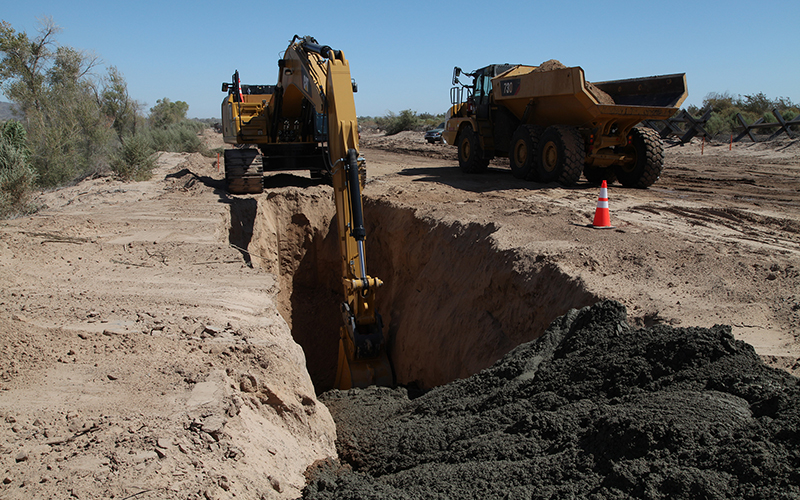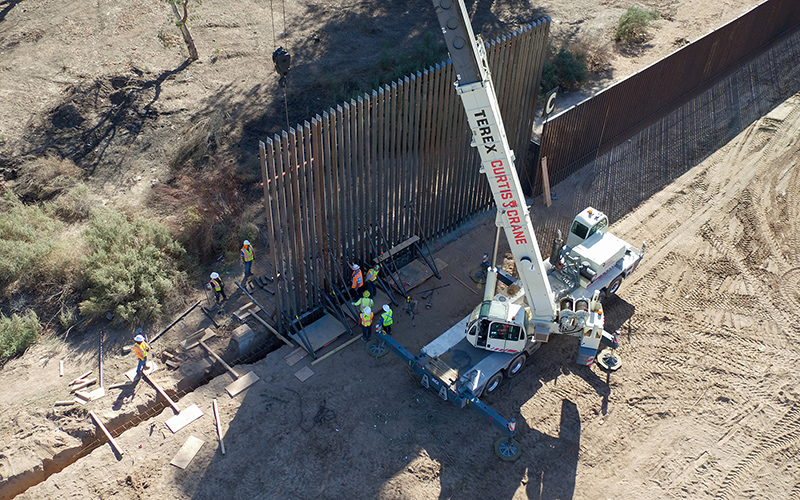
Army Corps of Engineers contractors pour concrete in August for the base of a new section of border wall near Yuma. The Department of Homeland Security waived environmental and other regulations on 90 miles of Arizona’s border last year to smooth the way for border wall construction projects. (Photo by Vincent Mouzon/Army Corps of Engineers)
WASHINGTON – The Trump administration waived environmental and other regulations on nearly one-quarter of Arizona’s border with Mexico last year to ease the way for border wall construction, a review of government documents shows.
The Department of Homeland Security issued three separate “section 102” waivers this year covering 90.2 miles of border in Yuma, Pima and Cochise counties.
While there was some overlap, the new waivers followed exemptions issued under the administration of President George W. Bush that covered 242 miles of Arizona border.
The section 102 waiver, created as part of the 2005 Real ID Act, gives the Homeland Security secretary the power to waive “all legal requirements such Secretary … determines necessary to ensure expeditious construction of the barriers and roads.” That includes environmental as well as historic, cultural, archaeological and other protections.
“All of the laws that are supposed to be protecting these incredible landscapes on the border have been cast aside to rush wall construction,” said Laiken Jordahl, a spokesman for the Center for Biological Diversity.
But a U.S. Customs and Border Protection official said the agency is careful to protect building sites, even where it has a waiver.
“CBP’s environmental planning process includes analysis of potential environmental impacts from each border infrastructure project. We identify best construction management practices to minimize impacts on the environment to the greatest extent possible,” the spokesperson said in an email.
The 2019 waivers include sections of Yuma County along the Colorado River near San Luis; stretches of border in Cochise County west of Naco and across the San Bernardino National Wildlife Refuge; and a strip in Pima County on the Organ Pipe Cactus National Monument, running right up to the border of the Tohono O’odham Nation.
-Cronkite News graphic by Harrison Mantas
Most of the waivers issued this year affect ecologically sensitive parts of the Arizona-Mexico border, Jordahl said.
But it’s not just the environment that critics say is at stake: Section 102 also allows waiver of laws like the Native American Graves Protection and Repatriation Act that affect tribal communities.
In 2008, when a waiver was issued for the 75 miles of U.S.-Mexico border that bisects the Tohono O’odham Nation, tribe Chairman Ned Norris Jr. told a House committee that the ensuing border fence construction was like “a bulldozer parking in your family graveyard, turning up bones.”
The CBP spokesperson said last month that the section 102 waivers from 2008 are still in effect on the Tohono O’odham Nation, which is currently lined with vehicle barriers stretching the entire 75 miles. But she also said the agency “does not currently have plans for new border wall construction on the Tohono O’odham reservation.”
Border wall construction is going on in the neighboring Organ Pipe Cactus Monument, over the objections of the Hia-Ced O’odham, a separate tribe that calls itself the “Sand People.”
“Every time I see it (the wall), it pains my heart,” said Hia-Ced O’odham Chairwoman Christina Andrews.
She said the waiver includes the area near the Quitobaquito Springs, which is home to Al Arivaipia, the tribe’s ancestral cemetery. Others have raised concerns about the impact construction is having on the area’s scarce water resources. But without federal recognition, the Hia-Ced are limited in what they can do legally to protect their heritage.
“The pain that we feel … it’s hard to even describe,” Andrews said.
For Cochise County, Rep. Ann Kirkpatrick, D-Tucson, wrote Acting CBP Chief Mark Morgan in November asking how wall construction will impact the county, particularly the San Bernardino National Wildlife Refuge.
“As you may know, I am not supportive of a border wall,” Kirkpatrick’s letter read. “However, I would like to work together to ensure that the construction that is happening is done thoughtfully and with care to protect border communities and the environment.”
But Rep. Paul Gosar, R-Prescott, said through a spokesman that the waivers are needed.
“Donald Trump promised the American people he would build a wall to secure the southern border, and Congressman Gosar is pleased to see him keeping this promise,” the statement read.
The CBP spokesperson said new wall construction has already shifted “illegal drug and human smuggling activities … to areas with inferior legacy barriers.” That’s why replacing existing vehicle barriers with the newer, more effective border wall is critical, she said.
But Jordahl called the rush to build a wall misplaced when there are other ways to secure the border that would not risk damage to sensitive areas.
“We know it can be done with technology in a much cheaper and less destructive way,” he said.
He said the waivers simply skirt public oversight and obscure border wall alternatives – and the biodiversity and natural wonder of Arizona’s borderlands get lost in debates over walls and border security.
“I think so few people actually know what’s at stake and know just how spectacular the land, wildlife and ecosystem is on the border,” Jordahl said.

